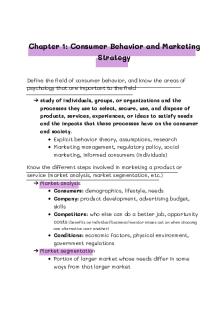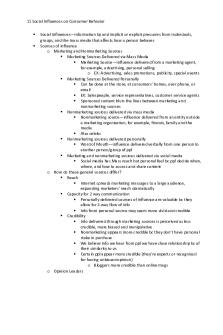Case Study on Subcultures in Consumer Behavior PDF

| Title | Case Study on Subcultures in Consumer Behavior |
|---|---|
| Author | Grace Parsons |
| Course | Consumer Behavior |
| Institution | St. John's University |
| Pages | 6 |
| File Size | 101.8 KB |
| File Type | |
| Total Downloads | 73 |
| Total Views | 170 |
Summary
Case Study on Chapter 13 'Subcultures' from the textbook: Consumer Behavior: Buying, Having, and Being (12th Edition) by Michael R. Solomon ISBN-13: 978-0134129938
ISBN-10: 0134129938...
Description
St. John’s University
Case Study #1 Chapter 13: Subcultures
Grace Parsons Consumer Behavior 3311 Professor Fabienne Cadet 2/9/17
According to chapter 13 of Michael R. Solomon’s Consumer Behavior , ethnic and racial subcultures are integral parts of our society, and will become even more so in future years. (Solomon) The U.S. Census Bureau predicts that by the next 45 years the hispanic and asian populations in America will double. The Bureau also claims that by 2050 the multiracial population in the U.S. will grow to 4 percent. (Solomon) As a result of this growth, marketers and businesses alike have had to come up with new strategies that attempt to target these fast growing subcultures. According to the text, the “big three” American ethnic subcultures to focus on are African Americans, Hispanic Americans, and Asian Americans, with the Hispanic population being the largest group. (Solomon) Marketers have recognized this and have begun to try and identify the products and services that would most appeal to individuals in these subcultures. In addition to race, there are also religious, age related, and location based subcultures. As expected, some attempts by marketers to target these groups have been successful, while others have been failures. The case study for chapter 13 involves the criticism by some of companies who choose to align themselves with values of a particular subcultures as a money-making strategy, think of the term ‘cultural appropriation’. It also raises the question of whether or not companies need to use unique marketing approaches anymore, if it reaches a point where a subculture is so “mainstream”. These are relevant questions, especially today as polarized political views and differing values have created a tense environment. Undoubtedly, people have been quick to criticize companies aligning themselves with views of subcultures as a money-making scheme. This is understandable, as people have every right to get upset at a company for “using” their culture to make money. While it may not be
your typical company, the Kardashians are a prime example of this. Millions of people keep up with the Kardashians every day, whether it be by watching their reality shows and spinoffs, following their Instagram and Snapchat accounts, or buying their products. According to the International Business Times, Kim Kardashian alone is listed as earning over $348 million in her lifetime. (Vultaggio) Money Nation reports show that the The Kardashian family is estimated to have a net worth of over $339 million. (Gerencer) There is no doubt why each Kardashian family member has a net worth in the millions: the family definitely knows a thing or two about marketing. Some have even referred to Kris Kardashian, the “momager”, as a marketing genius. However, many are very upset by their marketing strategies, and even call them racist. Critics of the Kardashians claim that they appropriate black culture. You may ask how this is done. Basically, in recent years, the Kardashians have been seen appropriating black culture more and more. Some of the ways are being seen wearing their hair in traditional black hairstyles like braids or corn rows, listening to music of black musicians and hip hop/R&B artists, and dating black people. (Bhambhani) Kylie Jenner, one of the younger Kardashian children, has even undergone plastic surgery to have lip injections done, giving her bigger, fuller lips. At first this may seem all well and good as it appears great that they are aligning themselves with the black community. However, are their intentions pure, or are they simply using this large and fast-growing subculture as a way to make money? Critics who argue that their intentions are bad say that they are indeed ‘using’ black people to make money. They claim that the Kardashians are taking advantage of black people by getting them to like them by assimilating into the culture and in turn, getting people to buy their products and watch their TV shows. They argue that while the Kardashian's are seen wearing
braids and other black hairstyles, dating black people, and associating themselves with black culture in terms of fashion, music, and more… they are doing and saying nothing when it comes to the problems the black community faces. For instance, you see the Kardashians on TV dancing to rap music, but do you ever see them using their celebrity spotlight to support black activism, or causes like Black Lives Matter? You see Kylie Jenner on social media sporting new lips and driving in her fancy car with her black boyfriend, but have you ever seen her stick up for black people, or make any kind of statement regarding issues in the black community, or the need for black people to be treated equally and fairly? To hear more criticisms, one can simply google search ‘Kardashians black culture’, and countless articles will surface that highlight the famous family’s lack of genuine concern for the black community. One of these articles is from the Daily Caller and is titled, “Black Lives Matter: The Kardashians are Racist and For Appropriating Black Style”. (Bhambhani) Another article, by Mic Network Inc. reads, “When will the Kardashian-Jenner family stop appropriating black hairstyles?” (Lubitz) It is evident that people care and are upset by the Kardashian family’s lack of concern for black issues. According to the Mic a rticle, American Actress Amandla Stenberg used Instagram to call out the Kardashians writing, "When you appropriate black features and culture but fail to use your position of power to help black Americans by directing attention towards your wigs instead of police brutality or racism." (Lubitz) These critiques can be summed up in one quote by Shanelle Matthews, a prominent Black Lives Matter activist, “Banking on blackness is a shameful enterprise, and the Kardashians are no better than racist judges, prison officials and corporations who make money off the incarceration of black bodies,” (Lubitz) Clearly it is never okay for companies to align themselves with subcultures solely as a way to make more money. It
will only end up upsetting those in that subculture, and possibly hurting the reputation of business. Aside from racial subcultures, marketers have targeted other social groups and at times have received backlash from religious subcultures. In the case study, it was mentioned how Wells Fargo supported the LGBTQ community by launching a national ad campaign, aimed at representing some of Wells Fargo’s diverse customer base. (Solomon) Unlike the Kardashians, it is pretty clear that Wells Fargo had good intentions, as the company refused to stop the ad campaign after several religious groups complained and started a boycott. The case study also brought up the question of whether or not there becomes a point where a subculture is so “mainstream” that marketers no longer have to use unique approaches. In some ways, this holds true. The gay and lesbian community is one subculture that has become more and more mainstream. Ten or Twenty years ago, an advertisement featuring a gay couple may have been seen by many as controversial. Companies may have wanted to steer away from ad campaigns like that because they would not want to offend anyone, such as members of religious subcultures. Today our society has made immense progress regarding the gay community. From TV shows to movies to newscasts and social media support, same-sex relationships have gained support and, at the very least, widespread attention. The term LGBTQ is a known by the average American. While marketers may still use unique approaches, in my opinion, it is less necessary as it is no longer as controversial to market to this subculture. Whether it be race, religion, age-related, or any other subculture, marketers must be still weary of the strategies they use, and be sure to have good intentions in their campaigns.
Sources
Solomon, M. (2017) Consumer Behavior. Edited by Stephanie Wall. 12th edn. United States: Pearson Education Inc.
Vultaggio, M. (2016) International Business Times . Available at: http://www.ibtimes.com/kim-kardashian-net-worth-update-kanye-wests-wife-could-lose-1m-mo (Accessed: 8 February 2017).
Gerencer, T. (2016) Kardashian net worth: Fame, fortune and family . Available at: http://moneynation.com/kardashian-net-worth/ (Accessed: 8 February 2017).
Bhambhani, D. (2016) Black lives matter: The Kardashians are racist for appropriating black style. Available at: http://dailycaller.com/2016/08/12/black-lives-matter-the-kardashians-are-racist-for-appropriating -black-style/ (Accessed: 8 February 2017).
Lubitz, R. (2016) Mic Network Incorporated. Available at: https://mic.com/articles/151142/when-will-the-kardashians-and-jenners-stop-appropriating-black -hairstyles#.hIvI0qvng (Accessed: 8 February 2017)....
Similar Free PDFs

Case Study Consumer Behavior
- 3 Pages

Consumer behavior
- 5 Pages

Consumer Behavior
- 33 Pages

Lecture 6 Consumer Behavior
- 2 Pages

Consumer Behavior Final Exam
- 2 Pages

MCQs-Consumer-Behavior
- 24 Pages

Consumer Behavior quiz
- 1 Pages
Popular Institutions
- Tinajero National High School - Annex
- Politeknik Caltex Riau
- Yokohama City University
- SGT University
- University of Al-Qadisiyah
- Divine Word College of Vigan
- Techniek College Rotterdam
- Universidade de Santiago
- Universiti Teknologi MARA Cawangan Johor Kampus Pasir Gudang
- Poltekkes Kemenkes Yogyakarta
- Baguio City National High School
- Colegio san marcos
- preparatoria uno
- Centro de Bachillerato Tecnológico Industrial y de Servicios No. 107
- Dalian Maritime University
- Quang Trung Secondary School
- Colegio Tecnológico en Informática
- Corporación Regional de Educación Superior
- Grupo CEDVA
- Dar Al Uloom University
- Centro de Estudios Preuniversitarios de la Universidad Nacional de Ingeniería
- 上智大学
- Aakash International School, Nuna Majara
- San Felipe Neri Catholic School
- Kang Chiao International School - New Taipei City
- Misamis Occidental National High School
- Institución Educativa Escuela Normal Juan Ladrilleros
- Kolehiyo ng Pantukan
- Batanes State College
- Instituto Continental
- Sekolah Menengah Kejuruan Kesehatan Kaltara (Tarakan)
- Colegio de La Inmaculada Concepcion - Cebu








